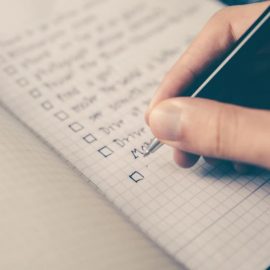

This article is an excerpt from the Shortform book guide to "10% Happier" by Dan Harris. Shortform has the world's best summaries and analyses of books you should be reading.
Like this article? Sign up for a free trial here .
Are you looking for tips on how to start meditation for beginners? What are the three meditation basics?
Dan Harris is the former self-help and meditation skeptic who wrote the book 10% Happier. In his book, he explains how meditation changed his life and why everyone should do it.
Here are Dan Harris’s meditation tips for beginners.
Incorporating Meditation Into Your Own Life
Want to know how to start meditation? For beginners, meditation can appear intimidating. But, after seeing how meditation changed his own life, self-help author Dan Harris now firmly believes in the benefits of practicing mindfulness and making meditation accessible to people who don’t know how to get started. He thinks anyone can improve their well-being by using meditation, which is free and doesn’t require anything to get started. We’ll discuss a few of his recommendations on how to start meditating and how to apply meditation to your life outside of your dedicated practice time.
How to Start Meditating
So how do you meditate? Harris recommends these basics:
- Sit comfortably.
- Focus on your breath. Pay attention to the act and sensation of breathing.
- When your mind wanders (and it will), calmly refocus your attention on your breath.
Harris emphasizes that it’s important not to criticize yourself when your mind wanders. The goal isn’t to have a completely clear head. The goal is to be able to quickly and calmly identify thoughts and feelings as they pop up and then come back to your breath. When stronger urges like itches or pain come up, Harris advises to take a mental note of it and let it go.
(Shortform note: Experienced meditators also advise beginners against this kind of self-criticism, noting that your mind is supposed to wander—that’s what your mind does. If you try to tell yourself to clear your head, this often has the opposite effect. For example, if we say, “Don’t think of a purple hippopotamus,” you’re probably thinking of a purple hippopotamus—the same is true of telling yourself to clear your mind. This means there will inevitably be days when your mind wanders more than others. Even if you think a particular meditation session didn’t go well, meditators advise against labeling it as bad. Instead, consider every meditation session as a good one, simply because you took the time to be present.)
There are other types of meditation, too. During Goldstein’s 10-day mindfulness retreat, Harris learned how to practice walking meditation. Walking meditation looks like this:
- Find a space where you can walk comfortably.
- Begin walking slowly back and forth along this path.
- Focus on the process of walking. Think about each step: picking up your foot, moving your leg, placing your foot.
- Repeat.
Harris notes that walking meditation isn’t the same as mindlessly pacing. You’re still focusing and refocusing your attention when it wanders.
(Shortform note: In Deep Work, Cal Newport suggests that you try productive meditation as a method to think of new solutions. This is when you work through a problem while doing a low-intensity activity like walking. But productive meditation differs slightly from walking meditation. Instead of focusing on the process of walking, as you do in walking meditation, productive meditation asks you to return your focus to the problem whenever your mind wanders.)
Harris notes that, just like any kind of practice or exercise, you should start meditating in small increments and work your way up. Harris cautions that it probably won’t be easy at first, and your mind will frequently wander. As with any kind of exercise, you’ll notice results when you practice meditation regularly. Harris started with just a few minutes every day, and after months of practice, he slowly progressed to half an hour or more of meditation. Harris believes meditating five minutes every day is better than 30 minutes once a week.
Harris further recommends that you focus on small wins, not on immediate and total transformations. He believes that meditation won’t fix all of your problems, but it will teach you how to deal with them better. This is why Harris claims meditation will make your life 10% happier, not 100%—it might not improve your entire life, but it will provide small benefits.
For example, Emma and Charlie hear their friend describing the life-changing benefits of waking up at 5 a.m. Emma tries it, but after one week of waking up early, she sleeps through her alarm. She gives up, deciding that waking up early doesn’t change anything and that she failed. Charlie also begins waking up early. He starts gradually, setting his alarm 30 minutes earlier each week. Eventually, he starts waking up at 5 a.m. If he misses a morning, he resumes his habit the next day. After a few months, he notices a difference in his productivity, and he likes having the extra time in the morning to complete his workout.
| Build Your Meditation Practice Starting a meditation practice doesn’t have to be a big time commitment—Harris recommends starting with just five minutes a day. James Clear echoes this advice in Atomic Habits, and he offers ideas on how to make that happen. He explains that to build daily habits that last, you should start with small, achievable habits. For example, rather than having a goal of meditating for an hour every day, start with just one mindful breath or five minutes of meditation. Building a meditation practice shouldn’t be unenjoyable. You can explore other kinds of meditation, and find one that works for you. Candle meditation: Light a candle, and turn off the lights in the room. Sit comfortably, and focus on the candle flame. This is similar to breath meditation, but rather than focusing on your breath, you’re focusing on a candle flame. Mantra meditation: Sit comfortably, and focus your attention on a word or phrase. You can say this word or phrase out loud or silently to yourself. Many meditators use the word “Om,” but you could also try something simple like, “calm.” Progressive muscle relaxation: This method is often used to help with sleep. Lay down and slowly begin tensing parts of your body. After tensing for up to 10 seconds, relax the tension. Then move on to another part of your body. |

———End of Preview———
Like what you just read? Read the rest of the world's best book summary and analysis of Dan Harris's "10% Happier" at Shortform .
Here's what you'll find in our full 10% Happier summary :
- A skeptic’s journey through the world of self-help
- How to control your anxiety, manage your ego, and become more compassionate
- How you can improve your life and career—even by just 10%







Mantra meditation is the practice of deep focused listening to a mantra in a meditative state to fulfill a certain intention. Mantra meditation is an excellent tool to raise one’s vibrations, overcome suffering and strengthen one’s powers of attraction.